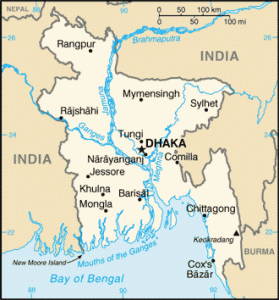Once in a while I hear a word which causes the most curious knee-jerk reaction harking back to my formative school years.
For example, whenever I hear the word “Bangladesh” my mind automatically and violently spits back “Dhaka!!!!!”
Take this to be a testament to my 7th grade geography teacher.
Similar reactions occur when I hear Lima (Peru!!!!!), or Bhutan (Thimphuuuuuu!!!!). The exclamations marks are subtle compared to how passionately these words materialize. Once out of my subconscious, they rattle around my brain for hours, like a song you can’t get out of your head.
So here we are in Bangladesh (Dhaka!!!!) where the climate is tropical and the weather is sunny with alternating floods, droughts, and typhoons.
Although more than half of GDP is generated through the service sector, about 45% of Bangladeshis are employed in the agriculture sector, with rice as the single-most-important product. (Source: CIA World FactBook)

Let’s talk a bit about their food.
Generally speaking, the food of Bangladesh is reminiscent of Northern Indian and Middle Eastern food. Some of the spiciest food in the world comes from this region.

Bangladeshi enjoy fresh-water fish from their rivers and others from the sea (favorites include catfish, eel, squid, and shrimp), some beef (although not for Hindus, who consider the cow sacred), rice, dal (lentils or other pulses boiled with salt and turmeric with the later addition of fried spices blends called tadka), and all sorts of curries. In the east they also enjoy great quantities of lamb.
Fresh fruits and vegetables are bountiful, including bananas, mangoes, melons, long beans, okra, lentils, and chickpeas.
Dairy products are more common in the east because the geography is more suited to raising herds. In the rural west yogurt and ghee/butter are rarely used. The only exception is dessert; sweets are traditionally made with milk or other dairy products. These include Ras Malai (sweetened paneer – homemade cheese – seasoned with cardamom and panadan extract, sitting in clotted cream), shir-e-faluda (vermicelli in spiced cream, honey, and nuts), cream cheese (chhana) soaked in syrup, and shirberanj (sweetened rice seasoned with spices and rosewater).
Pungent mustard seed and mustard oil are added to many dishes in this area as is tamarind, which imparts a sour (tok), lemony taste to food. Looking for the Bangladeshi “5 spice”? They call it Panch Phoron/Porch Foron – a blend of fennel seed, mustard seed, black nigella, golden fenugreek and brown cumin seed (measure in equal parts). Add hot chili powder and you’ll be eating Bangladeshi in no time! Prefer Garaham Masala? (coriander, cinnamon, cumin, cassia, clove, cardamom, anise, mace, bay leaf, wild onion seed, and chili) No problem, they use this easily obtainable spice blend too.
With all of these fantastic flavors I, for one, am looking forward to eating some Bangladeshi! How about you?




4 Comments